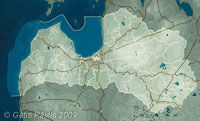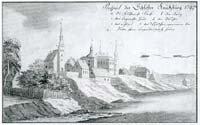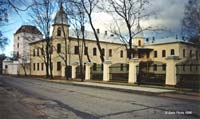
| Coordinates: | 56°30'40,2'' N 25°51'31,7'' E Google Maps |
| No: | 11 (full list of landmarks) |
| Category: | Medieval castles, Palaces and manor houses |
| Address: | (Jekabpils district), Jekabpils, Krustpils, Riga Street 214, left bank of Daugava at the mouth of Donavina (Dzirnupite) stream, some 200 metres east from the Krustpils Lutheran church |
| Year of construction: | Archaeology monument of state importance No.904, architecture monument of state importance No.6308. (together with the Lutheran church) |
| Condition: | Good |
| Values: | Architecture, archaeology |
| Conservation status: | Archaeology monument of state importance No.904, architecture monument of state importance No.6308. (together with the Lutheran church) |
More on medieval castles:
- 12 most interesting medieval castles in Latvia
- History of medieval castles
- Complete list of Latvian medieval castles
- Location of medieval castles in Latvia
Brief description
One of the best preserved medieval castles in Latvia is Krustpils castle. At the same time it is little investigated - the castle was used for military purposes for most part of the 20th century. Most likely the castle is built at the end of 13th century as a castle of Riga Archbishopric but in next centuries it was an apple of discord between Livonian order and Riga Archbishopric. At the end of medieval times it became a property of Korff family, obtained Barocco features and in perfect condition survived up to the 20th century. Only in 20th century castle has been let down - but at the same time this allowed to avoid the 20th century rebuildings characteristic to more adroit owners of castles.
During the last decade there is ongoing active investigation and renewal of the castle. Significant elements of landscape and great future values are 29 preserved household buildings of the castle complex. If all this complex would be carefully renovated one day, Latvia would gain one of its most impressive and interesting monuments of architecture.
Other names, origin of name
Most often used German name - Kreutzburg. For the first time mentioned in 1318 as Crusebach, other names - castrum Cruxburgh, Cruceborg, Creutzburg, Krutzborch, Crutzborch.
History
Medieval times
In the surroundings of contemporary Krustpils the first medieval castle and the first castle of Archbishopric of Riga was located in Asote (Aszute) - these lands came under governance of bishop in 1212 after the division of Jersika state. Pope Alexander IV confirmed the properties of Riga archbishop and his posterity in 1255 - this list includes Asote but there is no Krustpils in this list - thus there was no castle in Krustpils in this time.
For the first time Krustpils castle has been mentioned in 1318 - among the castles arbitrarily taken by Livonian order from Riga Archbishopric. As the war between Livonian order and Riga archbishop started already in 1297 - we could consider that the castle was constructed in the second half of 13th century - between 1255 and 1297. Also in 1359 archbishop of Riga Bromhold von Vyffhusen complaied to pope in Rome about the fact that Livonian order has taken again seven castles belonging to Riga Archbishopric - Krustpils among them. Due to this archbishop could not collect taxes in respective regions. In 1375 Lithuanians under Kęstutis invaded Riga Archbishopric and also the region of Krustpils as well. Krustpils was in hands of Livonian order also in 1484.
There was also a town next to the castle in medieval times - most likely it was located in the area of current church, between Daugava river and Donavina (Dzirnupite) stream. This settlement has been mentioned in 1511 for the first time - there was mentioned a fact that archbishop Jasper Linde has rented out a location for inn in this settlement.
During the Livonian war in 1559 the castle was devastated. When Livonian state was dissolved, Krustpils became a property of the king of Poland. Stephen Báthory of Poland granted a large area including Krustpils to general Nikolai von Korff (1555-1618). Family of Korffs possessed the castle until 1920. It is characteristic that boys in Korff family most often get named - Nikolai. This creates significant difficulties for contemporary historians who try to set apart deeds of each Nikolai.
17th - 19th centuries
Korffs obtained even more properties through successful planning of marriages, including marriage to Nereta noblewomen Catherine von Effern. Members of Korff family often choose military careers, for most part in Polish army. In 1618 Korffs established a Lutheran church and also in later times Krustpils (which is located in Catholic region) retained strong Lutheran influence. As Krustpils castle became a residence of landlord, it gradually lost its medieval character. In 18th century castle got representative look, towers had Barocco styled cupolas and spires, blocks had French roofs. One more larger rebuilding took place in 1849. In general the castle was kept in a very good condition until the beginning of 20th century. There was built large number (48!) of household buildings around the castle, all together forming a small town. Nowadays there have survived 29 of these structures, most have been rebuilt beyond recognition. Last landlord of Krustpils castle was Boris Konstantin Friedrich von Korff (1883 - 1946). His posterity moved over to Germany.
20th - 21st centuries
During the First World War Krustpils was located close to front-line but happily did not suffer much. Krustpils castle together with other buildings of complex was transferred to Latvian army after the war, in 1921. Here was located artillery regiment of Latgale. During the Second World War here was located infirmary of German army, hospital of Red Army was placed here after August 1944.
During the Soviet times (until 1991) in the castle there were located regiments of Soviet army - 16th regiment of long-range intelligence aviation and main storehouses of 15th air regiment. For 50 years the premises were not managed and were close to be considered as ruins.
Jekabpils Museum of History took over the complex of the castle on 13th April 1994 - some buildings of castle they received somewhat earlier. Since this time there is on-going gradual research and renewal of the castle, there is made also a new roof. When the castle was regained from army, there have been discovered numerous construction details and artworks unknown thus far. Krustpils castle thus is one of the most authentic and well preserved medieval castles in Latvia.
Description of the construction
Outward fortifications
Castle has been built on right bank of Daugava, along the castle there is also a small stream - Dzirnupite or Donavina. Castle is located in some distance from the steep valleys of Daugava and Dzirnupite but both steeps still serve as a kind of earthen fortifications. It is possible that other sides were protected with a moat as well but there have not been preserved traces of it.
Build of the castle
Krustpils was the easternmost of the castles of Riga Archbishopric - due to this castle was well fortified.
As for most part of 20th century castle was used by army with its secretive approach to civilians, the building was little researched until 1990ies. Construction history of the building is complicated - the enormous building has been rebuilt and extended many times during the long centuries. There are differing views of several specialists regarding the identification of medieval parts of the building.
Most likely the massive gate tower belongs to medieval age as well as basements with barrel vaults and cross vaults, buttresses.
During the rebuilding of 1622 there was working a master of stoves from Nereta.
Monuments of art and other interesting details
Castle has got ornate portal of entrance in inner yard. It consists of two caryatids, holding up volutes. Upper part of volutes transforms in festoons of fruits and leaves.
In the second floor, in the former dining hall there has been preserved coffered ceiling with a rosette in centre. Coffering is creating an attractive ornament. It is possible that it was made in times when Roccoco became popular again - it was so called "neoroccoco" style which was popular in 1880ies - 1890ies.
In one room in the first floor there was found a wall decoration - faux marbling. In stairway there has been preserved a wall-painting which includes also coats of arms of Rosens and Korffs.
Other pictures
Investigations
- 1792 - J.C.Brotze, description and drawings;
- 1902 - K.Löwis of Menar, drawing of plan;
- 1995 - 2001 - A.Sne, archaeological supervision during the installation of communication networks;
- 1990ies - J.Zviedrans and I.Dirveiks, architectonic and art survey.
Linked landmarks
- Historical centre of Jekabpils town, Krustpils part
- Krustpils Lutheran church
- Pedestrian bridge at Krustpils church
References
- Caune A., Ose I. Latvijas 12. gadsimta beigu - 17. gadsimta vācu piļu leksikons. Rīga, 2004.
- Zilgalvis J. Pearls of Latvia. Full color guide to 40 of the most beautiful castles, palaces and manors in Latvia. Rīga, 2000-2001.
- Website of State Heritage Inspection http://www.mantojums.lv, accessed in 21st December 2008








